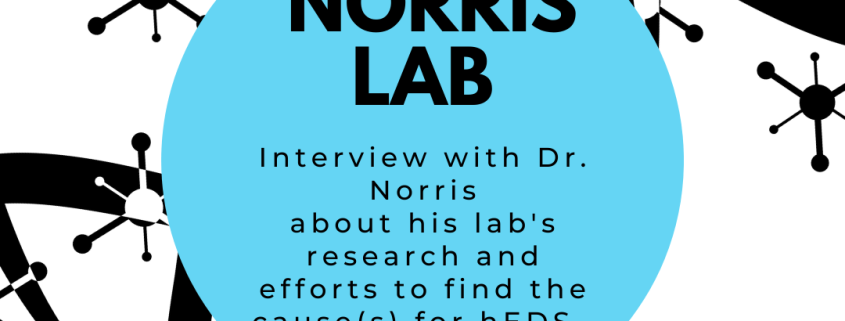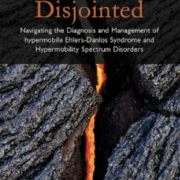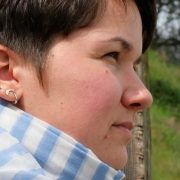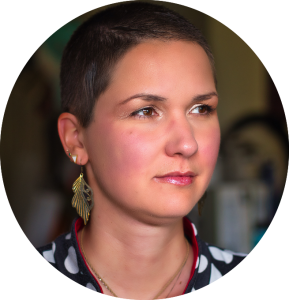Interview with Dr. Norris on finding the genetic cause(s) for hypermobile EDS and much more
For Chronic Pain Partners, I had the honor to speak with Dr. Russell “Chip” Norris from the Norris Lab at MUSC, a research laboratory dedicated to finding the genetic cause(s) for the hypermobile Ehlers-Danlos syndrome. Sturm speaks with Norris about their current research and how it will change care for people with hEDS.
[The final findings – meaning the gene the lab discovered for hEDS – are not yet officially published in a medical journal and therefore cannot be discussed in this interview. We will update our readers as soon as the results are out.]
Karina Sturm:
Hi Dr. Norris! I feel so honored that you took the time to talk to me today. I know you and your staff are working so hard, and I appreciate all you do! Now, I don’t think I need to introduce you to our readers because your lab has made the news many times due to fulfilling one of the most necessary needs of a large part of the community, people with hEDS. Together with a dedicated team of researchers, and I want to mention Dr. Cortney Gensemer specifically, you have worked on finding the genetic cause for hEDS for a while now. Can you tell me why you got interested in hEDS research and the complex task of finding a gene for hEDS particularly?
Dr. Chip Norris:
Until four years ago, I wasn’t interested in EDS. I didn’t know much about it besides it was always one slide that I showed in presentations about mitral valve prolapse. Patients with EDS have a higher incidence of mitral valve prolapse. So I really didn’t know much about it four years ago, but every year, new PhD students come in for orientation, and I always offer them help. Sometimes students take me up on it; sometimes, they don’t. The smart ones take me up on it. [Laughs] I had this girl [Dr. Cortney Gensemer] come in. She sat down in my office and she had no idea what she wanted to do, which is like most of the students. She knew she wanted to be in research, but she didn’t know what area of research. So she asked me what I did. I said, “Well, I work on the genetics of heart valves and heart disease, and I have these large networks of geneticists and cardiologists I work with. And she said, “That’s interesting because I might develop a prolapse as part of this connective tissue syndrome I live with.” I asked her what the causative gene was, and she responded that nobody knew what it was for her EDS type, hEDS, even though it was the most common one. I asked, “How common is it?” And she responded that there was a report that stated 1 in 5000, but that it was not really based on much data. She said there was also a new report that said 1 in 500. And I said, “Do you want to work on Ehlers-Danlos syndrome for your PhD?” She agreed, and we started it. But it was also clear that this had to be a side project for Cortney because getting large families with the condition is always a challenge. Also, we didn’t know whether this project would lead us anywhere. We were able to get one large family, and that’s where we started. From that, we found something interesting…
[The phone rings]
Sturm:
Do you need to take this?
Norris:
Sorry, I normally have my phone off because a lot of people find me online.
Sturm:
They are calling you on your office phone?
Norris:
Yeah.
Sturm:
Oh wow. Well, I assume they are all as curious as I am to learn more about your findings. [Laughs] We can finally talk about those (once they are published). But back to the previous question.
So your lab found something interesting in this one family Dr. Gensemer initially studied. Tell me more about that. I assume you did whole genome or exome sequencing? Can you give me some insight into what methods you used? How did you recruit all these people, and what happened then?
Norris:
We took the two most distantly related individuals, who were second cousins, and did Whole Exome Sequencing (WES) [a specific method to analyze large parts of the human DNA for genetic mutations] on those two individuals. At that point, we knew there were multiple affected people in the family, but we hadn’t really expanded our focus to anyone else in the family yet. We narrowed the results down to 14 shared rare predicted damaging mutations. And meanwhile, we also screened all the other genes that were known to be causative for other types of EDS. Then we individually Sanger sequenced for those variants that we identified in the family, which further narrowed it down to one gene. That was a starting point for us. As a consequence, we had to move forward into an animal model to try and validate the gene. We use CRISPR -Cas9 genome editing [a technique that can be used to change the genome of an organism; in this scenario it is used to put a human mutation into a mouse], which enabled us to put the human mutation into the mouse and then ask the question: Does the mouse have EDS?
Sturm:
And did it?
Norris:
Mice are really hypermobile to begin with. They’re able to bend their bodies in ways a human cannot. The 2017 criteria for diagnosing hEDS are not relevant at all for mice. We had to be creative and come up with other ideas on how to assess the connective tissue. We do that in a few different ways. One is to measure the strength of the connective tissue. We chose the Achilles tendon because the Achilles tendon is the largest tendon in the mouse, and the experiment is relatively easy. You put the tendon between two clamps, pull the clamps apart with a certain force, and this allows us to measure how stretchy the tendon is and what force it takes to break it. The benefit of this approach is that you get real quantifiable measurements. We found that the connective tissue was far weaker and stretchier in the EDS mice we generated compared to healthy mice. Then we went on to the ultrastructural level, which means we looked at the collagen and how it is different. And we certainly saw changes in the collagen in our animal models as well, both in the skin and in one tendon. The collagen fibrils are not the same when compared to the wild type. But we wanted to go beyond that and look into comorbidities. Since we knew the clinical features in the family that we identified, we wanted to see whether or not the animal had things like mast cell activation syndrome and gut dysmotility.
Sturm:
How do you measure these things? I assume diagnosing these comorbid conditions must be even harder in mice than in humans.
Norris:
There are some good markers for mast cell activation in humans. For our initial testing of our mice, we asked three questions: 1. Is there an increase of mast cells in the gut or the skin? 2. Are the mast cells in these areas degranulating? 3. Can we measure serum level tryptase? So really, it’s looking at biopsies and serum level of tryptase. And our findings were very encouraging.
Sturm:
These results all come from one large family, right? And I assume you recruited more than one family? Can you tell me a little more about how many people were involved in your study, and did they all have mutations on this gene you found (or even the same mutation as your initial family)?
Norris:
We’ve completed sequencing on 700 people in total, and yes, we have found the same mutation in some of those people.
Sturm:
Oh, wow. That’s a good number of people for a study.
Norris:
Additionally to those 700 that we used to screen for mutations, we recently completed 250 WES. Those are being analyzed by Cortney, who will also find out what the frequency of the variant in the general population is. There are many other open questions, and I think the answers will be very interesting.
Sturm:
I am so curious. I’m dying to know what you find. I hope that your results will help many of us gain credibility. I can only speak for myself, but in Germany, I have experienced many times that patients who don’t have a causative mutation are not getting a full hEDS diagnosis; they always only get “suspected hEDS” on their clinical reports, which is a huge issue if you try to apply for disability or any mobility aids since it always leaves room for doubts. So I hope that if some of us can “prove” – we should not have to prove anything, though – that we have a genetic mutation that causes our hEDS, life might become easier in some areas, at least.
Norris:
I think what’s important to understand is that this first paper is not going to solve all of the EDS genetics. We don’t know all the genes.
Sturm:
But it is a start. And I guess we need to start somewhere.
Norris:
Yes, it’s a start. We’ll be able to provide an estimate on how many people have these mutations. But that’s why it’s really important to do more population-based genetic studies. I hope the HEDGE study will be incredibly revealing.
Sturm:
This is a question you likely get asked all the time, but I must ask: When do we finally get to see your results? Can you give me a date? How long do we have to continue to wait?
Norris:
Nobody wants this paper more than I. Look, we could publish it now. We could throw it in right now, even without analyzing the 700 extra people. And believe me, when I reach my point of being really frustrated, maybe I’ll do that. But I think it’s a disservice to the EDS population to haphazardly just throw it in.
I’ll give you an example. In our first paper in Nature, we published the first mutation discovered for patients with mitral valve prolapse. We used a similar approach that we’re using for this paper. We identified a large family, made a mouse model and confirmed that mouse had a prolapse. It was a pretty straightforward approach. From initial submission to actual acceptance, it took us a year and a half because reviewers wanted us to do a whole lot of new experiments.
Sturm:
Yeah, I know. I worked as a research associate before I became sick and have experienced how long it can take from the first experiment until you actually get to publish your results. I understand you cannot give us a definite date, but can you give us something?
Norris:
I do have an idea of when I’ll have a plan for the submission of the revised version, which is probably in the next three to six months.
Sturm:
This must be very frustrating for you if you get this question all the time, but lots of people see your work as hope for better care in the future, so I guess it’s only fair to ask.
Norris:
Yeah, we get it every time. There are a lot of big names on this paper, and we seek advice and recommendations from all of them. It’s important to get it right. And it’s important to know what the numbers actually tell us.
Sturm:
So here’s another question that you probably get asked every time. [Laughs] In your opinion, is there more than one gene for the hypermobile EDS?
Norris:
The way I answer this is: if there was only one gene, it would have been found a long time ago. It’s not going to be just one gene. How many genes is it going to be? I don’t know. A lot.
Sturm:
On to a more personal note: I have a heterozygous TNXB mutation, which is something a lot of people in the community have, but all of us are kind of left behind because we are not included in the recent classification. You only have clEDS when you have a full TNX deficiency, which only people with homozygous mutations have. So for all the many people with EDS and heterozygous mutations who also often don’t quite fit the hEDS description or the clEDS description, it seems like we are somewhere in the middle of it all. We have no idea of our EDS type and progression. Do you feel heterozygous TNXB mutations may be important for your future research on hEDS genes?
Norris:
I think working with the patients, listening to the patients, and trying to understand whether or not their specific mutations are contributing to their disease is what we need to do. I think individualized, personalized research is a really cool way of building projects and understanding more about the disease. So taking your mutation and putting it into constructs and cells and mice is really relatively easy if there are funds to do it.
Sturm:
Well, I am happy to give you my mutation if you want to research it? [Chuckles] I am only half-joking, though. It would be really helpful for me to know for sure that my mutation is more than only predicted to be disease-causing.
Norris:
I think there are enough people and enough interest around TNXB that it’d be good to have some follow-up on it biologically and genetically. It’s something that we’re looking at with our biomarker study, but it really needs to go beyond that. There needs to be an efficient way to test not only TNXB variants but other variants of unknown significance and see if they are indeed significant. So, it’s definitely on our radar. It’s something that we’re keeping an eye on; something we’ll probably start pursuing over the next few months.
Sturm:
Oh, that would be cool!
Norris:
There are a lot of variants of unknown significance that could be interesting. The challenge is the question: Do you need multiple gene variants that together have a bigger impact on the disease? That’s harder to uncover.
Sturm:
Yeah, that sounds very challenging to find out. However, you have this huge benefit because your lab consists of scientists who have EDS themselves, right? They must be so excited to explore all these areas that directly affect themselves. In what ways do you feel having scientists with EDS in your lab improves your research?
Norris:
I think it’s important to build a community of scientists and health care providers that understand the disease because it’s so woefully misunderstood. So part of our initiative is to build a community of providers that are passionate about the disease and can actually, in the future, help educate and advocate for those affected by this disease, promote awareness, and then treat patients and not dismiss them. That’s a major driving part for having these patients in the lab working on the disease. So the other important factor is that these patients, in general, are not listened to. So when you think about what is the right experiment – what is the right question to be asked – I can read the literature and say, “Okay, I want to figure out X, Y, and Z.” But for us in the lab, it’s much more personal than that.
And I think we want to hear what the patients have wrong with them directly from the patient, not from a paper. Essentially, you can use the patient in the lab as an important resource. I only provide the guardrails of how to go about testing those questions and developing the hypotheses. I think having them in the lab and having that context is incredibly powerful. It also provides at least a small group of patients with a greater purpose. They are all disabled. And providing them with the purpose of understanding why that is, and that what they’re finding can apply to other disabled people, is really empowering for them. It helps guide the science. I hope that we can be the poster child not only for hEDS, but for other diseases that need a voice and that other labs will realize that an intern program around the disease they are studying is really important. And bringing patients into the lab to make patient scientists is an innovative idea that really should be applied to every single academic institution in this country.
Sturm:
However, doesn’t this also come with lots of challenges? I mean, EDS always comes with fatigue and chronic pain and more symptoms that can influence our daily lives quite a bit. How do you navigate those challenges in your lab, and what kind of accommodations do you provide to your intern and PhD students, so that they can successfully study as disabled and chronically ill people?
Norris:
We try to make things easy for them. Where they’re housed is not directly on campus. So I have a personal shuttle that picks them up, drops them off right at the doorstep.
Sturm:
Nice.
Norris:
Some choose to walk, but Charleston in the summer is hot, especially if you have POTS, and everybody has joint pain, so it can be really problematic. They’re not standing while they’re doing the science. They’re sitting down. We have lower benches. We have bench shelves that come out to where they can sit and work. Some people need to take the afternoon off and that’s fine. We understand that that’s how it is with all of our experiences. Are they going to work 12 hours a day? No. Do we want them to work 12 hours a day? No. I don’t want my other PhD students working 12 hours a day. It’s just not healthy. So it’s completely up to them. If they want to come in for two hours, they come in for two hours.
Sturm:
I should be working for you.
Norris:
What’s interesting is that the efficiency and the productivity are equal. And something that we found in our register of our intern program when we’re going through school transcripts: These people are brilliant. They are so bright. These are high-achieving people, and this is what I see across the board.
Sturm:
What do you hope to achieve with your research goals? What’s your short-term versus long-term goal?
Norris:
A short-term goal is to finally get this paper out. As you are getting older, you start thinking about what legacy you want to leave. You never know what footprints you’re going to leave in the future. I just hope that when you look back on it in the future, you can say the engine is still going forward; that we have built something sustainable. Saying a cure is a little bit far, but if we can stop – or improve treatment options for – some of the comorbidities that are associated with hEDS, like mast cell problems, gastroparesis or chronic pain, that’s going to be beneficial for the patients.
There’s also the option for personalized medicine. It’s something that we’re thinking about very heavily right now. Every patient with EDS is unique for their zebra stripes. I think we need to start thinking bigger than only this one gene we found. For some patients, it’s going to be a combination of several genes combined with environment combined with activity; all these things are going to factor in. So you have to look at it from a personalized medicine approach, in my opinion. You have 14 years on average to get a diagnosis without diagnostic markers for hEDS at the moment. Say we do all this, and maybe we find genes for 20 or maybe even 50 percent of the patients. If we can reduce that 14-year average down to 14 months, that would be awesome.
Sturm:
Oh yes, that would be amazing, especially because lots of the damage is actually caused by misdiagnoses: physical harm, mental harm and financial. So, yeah, if you could reduce these years down to a couple of months, that would be perfect.
Norris:
I think we need to have EDS institutes in every state. I think we need to have congressional backing for supporting the infrastructure to treat these patients, embrace the patients versus repel them. If those things happen and if we can play a part in that process, then I think we’ve done a good job.
Sturm:
Yes, if you can actually make it happen that every state has an expert center for EDS, you have done more than a good job.
Norris:
When we look at it, our estimates are that 800,000 people in the US have hEDS, and that makes 8,000 people in the state of South Carolina based on per capita. If we open an institute, we can’t see 8,000 new people a year. And people are coming to us from all over the country already to see our neurosurgeons, our physical therapists, our orthopedic surgeons. We need more centers of excellence to see these patients and not dismiss them.
Sturm:
True.
Norris:
I don’t know if it’s going to happen, but we’re trying to do what we can to make that happen in South Carolina.
Sturm:
Perfect.
Norris:
I hope other people will follow suit.
Sturm:
Yeah, me, too. I, unfortunately, do not live in the US anymore, but I just hope if you make all of your goals happen, maybe other countries will be able to replicate it, and, in the end, we will all benefit!
Thanks, Dr. Norris. I don’t want to keep you any longer, since you have already met with me twice in two days! [Laughs] [I couldn’t keep the interview short enough, so when we couldn’t finish all questions on the set date, Dr. Norris talked to me again the next day.]
I hope you continue with your work and can’t wait to read this paper everyone is talking about. Thank you for your time and for all you do.
Norris:
Thanks, Karina! Have a good day. Bye.
Right now, the lab is completely reliant on donations. So if you’d like to support their work, you can do so here:
https://www.thenorrislab.com/donate
This article was originally published as part of our Chronic Pain Partners Post Newsletter and on the Chronic Pain Partners website: https://www.chronicpainpartners.com/interview-with-dr-norris-on-finding-the-genetic-causes-for-hypermobile-eds-and-much-more/








 Karina Sturm
Karina Sturm 



Leave a Reply
Want to join the discussion?Feel free to contribute!